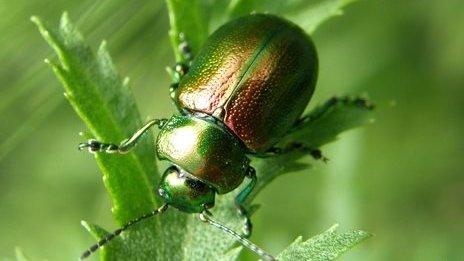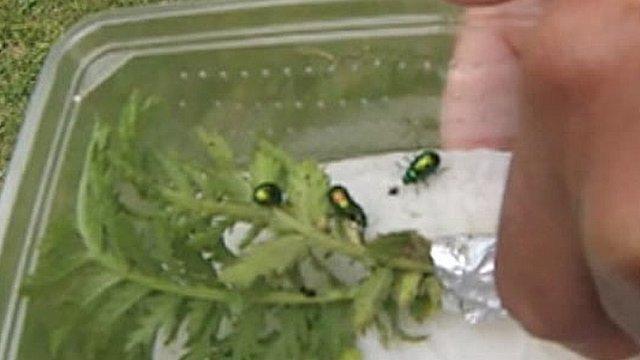Yorkshire tansy beetles travel to Cambridgeshire in buckets
- Published
The beetles were once widespread across the UK, but the species was last seen in Cambridgeshire 32 years ago
Hundreds of "very rare" beetles have been loaded in to buckets and brought down the A1 from Yorkshire to a new habitat in Cambridgeshire.
Tansy beetles were thought only to exist along the River Ouse in York until one was discovered near Huntingdon last month.
After a "bumper breeding year" hundreds of York beetles have now been relocated to Wicken Fen in Cambridgeshire.
It is hoped this new "hospitable" habitat will help to increase numbers.
The beetle takes its name from its main food source, tansy (Tanacetum vulgare), a perennial herb.

It is hoped the beetles will settle into their new "hospitable" habitat
The beetles were once widespread across the UK, but the species was last seen in Cambridgeshire 32 years ago.
It is now considered "critically endangered" and is a conservation priority species in England, which means public bodies have a duty to protect it, together with its habitat.
The iridescent leaf beetles' reintroduction at the Cambridgeshire nature reserve is in a joint project between The National Trust, Buglife and the Tansy Beetle Action Group, with support from Natural England.
Vicky Kindemba, from charity Buglife, said: "By spreading this rare species to new places, we hope to reduce the risk that the species will become extinct in the UK."

The tansy beetle (Chrysolina graminis)

The tansy beetle is currently critically endangered in the UK and across its worldwide range
It is a conservation priority species in England which means that public bodies have a duty to protect it, together with its habitat
in recent times the beetle has only been found along a 30km stretch of the River Ouse, around York, mainly eating tansy (Tanacetum vulgare), a perennial herb which has given the beetle its name
Although the tansy is widespread along the River Ouse, land use changes and the increase of invasive species such as Himalayan balsam have resulted in a decline in the plants over the past few decades
Source: Natural England

Stuart Warrington, wildlife adviser for The National Trust, said: "We don't know exactly why this lovely beetle went extinct at Wicken Fen in 1982, but it may have been because the Fen was too dry and scrubby at that time.
"Lots of new habitat has been created or restored in recent years so we hope the beetle will find the site much more hospitable and will get firmly established."
- Published7 August 2014

- Published30 May 2013
